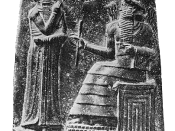An eye for an eye makes the whole world blind". This was said by Gandhi many years after the fall of the Babylonian empire. Judging by the laws of the Babylonian people, there was no insightful Mahatma Gandhi to spread his thoughts on equality and forgiveness. Though they were an advanced and organized society, the Babylonians were also extremely strict, almost cruel, when it came to law making. Revenge, faith in the gods' sense of justice, and inequality all made up a portion of the eight foot tall stone tablet that we now know as Hammurabi's Code of Law (Horne).
Hammurabi's reign lasted from 1795 until 1750 BC (Horne). Up until Hammurabi took control, there had been no ruler to publicly establish an entire set of laws. Written in order to regulate the organization of the Babylonian society, this code, consisting of two hundred laws, begins and ends by addressing the gods.
Revenge played a large role in the laws, as it was seen as the only way to truly be compensated. Almost all of the laws lack a true explanation; they were simply accepted as fair justice by the people.
However, one law in particular does have a reason behind it. "If an accused man claims to be innocent, he will be thrown into the river. If the man drowns, he is proven to be guilty. However, if he makes it to the opposite bank safely, the accused man is indeed innocent (Hammurabi)." This law gives us an important insight into the lives of ancient Babylonian society. Obviously, the people had a strong sense of faith in their gods. By tossing the man into the raging river, the people are putting the accused man's life into the hands of the gods. If the man was guilty and lying, the...


